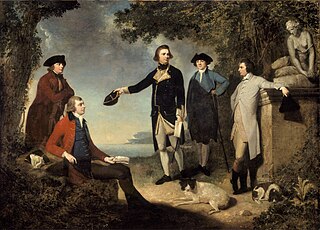
The Behistun Inscription is a multilingual inscription and large rock relief on a cliff at Mount Behistun in the Kermanshah Province of Iran, near the city of Kermanshah in western Iran, established by Darius the Great. It was crucial to the decipherment of cuneiform script as the inscription includes three versions of the same text, written in three different cuneiform script languages: Old Persian, Elamite, and Babylonian. The inscription is to cuneiform what the Rosetta Stone is to Egyptian hieroglyphs: the document most crucial in the decipherment of a previously lost script.

Carsten Niebuhr, or Karsten Niebuhr, was a German mathematician, cartographer, and explorer in the service of Denmark. He is renowned for his participation in the Royal Danish Arabia Expedition (1761-1767). He was the father of the Danish-German statesman and historian Barthold Georg Niebuhr, who published an account of his father's life in 1817.

Cuneiform is a logo-syllabic script that was used to write several languages of the Ancient Near East. The script was in active use from the early Bronze Age until the beginning of the Common Era. It is named for the characteristic wedge-shaped impressions which form its signs. Cuneiform originally developed to write the Sumerian language of southern Mesopotamia. Along with Egyptian hieroglyphs, it is one of the earliest writing systems.
Assyriology is the archaeological, historical, and linguistic study of Assyria and the rest of ancient Mesopotamia and of the related cultures that used cuneiform writing. The field covers Sumer, the early Sumero-Akkadian city-states, the Akkadian Empire, Ebla, the Akkadian and Imperial Aramaic speaking states of Assyria, Babylonia and the Sealand Dynasty, the migrant foreign dynasties of southern Mesopotamia, including the Gutians, Amorites, Kassites, Arameans, Suteans and Chaldeans, and to some degree post-imperial Achaemenid Assyria, Athura, Eber-Nari, Assyria, and Assuristan, together with later Neo-Assyrian states such as Adiabene, Osroene, Hatra, Beth Nuhadra and Beth Garmai, until the Arab invasion and Islamic conquest of the mid-7th century AD. Some Assyriologists also write on the further Assyrian continuity of the Assyrian people as well as the Mandaeans to the present.

Peter Forsskål, sometimes spelled Pehr Forsskål, Peter Forskaol, Petrus Forskål or Pehr Forsskåhl was a Swedish-speaking Finnish explorer, orientalist, naturalist, and an apostle of Carl Linnaeus.

Georg Friedrich Grotefend was a German epigraphist and philologist. He is known mostly for his contributions toward the decipherment of cuneiform.

Old Persian cuneiform is a semi-alphabetic cuneiform script that was the primary script for Old Persian. Texts written in this cuneiform have been found in Iran, Armenia, Romania (Gherla), Turkey, and along the Suez Canal. They were mostly inscriptions from the time period of Darius I, such as the DNa inscription, as well as his son, Xerxes I. Later kings down to Artaxerxes III used more recent forms of the language classified as "pre-Middle Persian".
The decade of the 1760s in archaeology involved some significant events.

Bayt al-Faqīh or Beit al-Faqih is a city in Al Hudaydah Governorate in Yemen. It is located on the pilgrimage and trade route across the Tihamah plain between Al Hudaydah and Ta'izz. It is 50 km south of Al Hudaydah and 150 km southwest of the Yemeni capital of San‘a’ and lies at an altitude of 122 m. Its population was 28,773 in the 1994 census and estimated at 41,652 in 2005.
Thorkild Hansen was a Danish novelist most noted for his historical fiction. He is commonly associated with his trilogy about the Danish slave trade including Slavernes øer (1970) for which he received the Nordic Council Literature Prize in 1971.
Al-Mahdi Abbas was an Imam of Yemen who ruled in 1748–1775. He belonged to the Qasimid family, descended from the Islamic prophet Muhammad, which dominated the Zaidi imamate of Yemen in 1597–1962.

The Apostles of Linnaeus were a group of students who carried out botanical and zoological expeditions throughout the world that were either devised or approved by botanist Carl Linnaeus. The expeditions took place during the latter half of the 18th century and the students were designated 'apostles' by Linnaeus.

Friedrich Christian Carl Heinrich Münter was a German-Danish scholar, theologian, and Bishop of Zealand from 1808 until his death. His name has also been recorded as Friederich Münter.
Events from the year 1761 in Denmark.
Frederik Christian von Haven was a Danish philologist and theologian who took part in the Danish expedition to Yemen.

Niels Ludvig Westergaard was a Danish Orientalist and professor.

The Prince's Mansion is a palatial Rococo-style mansion located at Frederiksholms Kanal in central Copenhagen, Denmark. It used to serve as the official residence of the Crown Prince of Denmark but now houses the National Museum of Denmark.
Lawrence J. Baack is an American historian of modern Europe, with a particular interest in Germany and Scandinavia, and a sub-specialty in Antarctica. He is the author of Agrarian Reform in Eighteenth Century Denmark, Christian Bernstorff and Prussia: Diplomacy and Reform Conservatism 1818-1832, and Undying Curiosity: Carsten Niebuhr and the Royal Danish Expedition to Arabia 1761-1767, among other works.
Jørgen Balthazar Winterfeldt was a Danish naval officer and philanthropist. He was admiral from 1804 and was awarded the Order of the Elephant in 1811. He established Winterfeldts Stiftelse at Klerkegade 25 in Copenhagen in 1805. He was chief of the Naval Cadet Academy in from 1782 until 1792.

HDMS Grønland (Greenland) was a ship of the line of the Dano-Norwegian Navy, built in 1756 and decommissioned in 1791. Grønland spent considerable time in the Mediterranean Sea, where she protected Danish merchant convoys. Grønland took part in the bombardment of Algiers in 1770 but otherwise did not see any action in battle. It is noted in the Danish Admiralty's papers that she was an unusually seaworthy ship.













